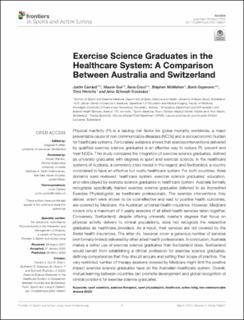| dc.description.abstract | Physical inactivity (PI) is a leading risk factor for global mortality worldwide, a major preventable cause of non-communicable diseases (NCDs) and a socioeconomic burden for healthcare systems. Fortunately, evidence shows that exercise interventions delivered by qualified exercise science graduates is an effective way to reduce PI, prevent and treat NCDs. This study compares the integration of exercise science graduates, defined as university graduates with degrees in sport and exercise science, in the healthcare systems of Australia, a commonly cited model in this regard, and Switzerland, a country considered to have an effective but costly healthcare system. For both countries, three domains were reviewed: healthcare system, exercise science graduates' education, and roles played by exercise science graduates in healthcare system. Australia formally recognizes specifically trained exercise science graduates (referred to as Accredited Exercise Physiologists) as healthcare professionals. The exercise interventions they deliver, which were shown to be cost-effective and lead to positive health outcomes, are covered by Medicare, the Australian universal health insurance. However, Medicare covers only a maximum of 5 yearly sessions of all allied-health services taken together. Conversely, Switzerland, despite offering university master's degrees that focus on physical activity delivery to clinical populations, does not recognize the respective graduates as healthcare providers. As a result, their services are not covered by the Swiss health insurances. The latter do, however, cover a generous number of services (not formally limited) delivered by other allied-health professionals. In conclusion, Australia makes a better use of exercise science graduates than Switzerland does. Switzerland would benefit from establishing a clinical profession for exercise science graduates, defining competencies that they should acquire and setting their scope of practice. The very restricted number of therapy sessions covered by Medicare might limit the positive impact exercise science graduates have on the Australian healthcare system. Overall, mutual learning between countries can promote development and global recognition of clinical positions for exercise science graduates. | en_US |

